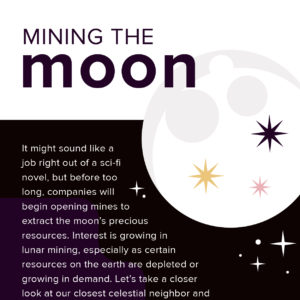Mining the Moon
It might sound like a job right out of a sci-fi novel, but before too long, companies will begin opening mines to extract the moon’s precious resources. Interest is growing in lunar mining, especially as certain resources on the earth are depleted or growing in demand. Let’s take a closer look at our closest celestial neighbor and why one company is angling to drill into it.
What the Moon Is Made Of
Like our planet, the moon has layers. At this point, we know only what’s on the rocky surface.
Minerals (1)
- Olivine
- Orthopyroxene
- Clinopyroxene
- Oxygen
- Silicon
- Magnesium
- Iron
- Calcium
- Aluminum
- Titanium
- Uranium
- Thorium
- Potassium
- Hydrogen
Did you know?
During the six Apollo missions between 1969 and 1972, astronauts brought back 842 pounds of moon rocks, pebbles, sand, dust and core samples. (2)
Helium-3
This element is rare on Earth, much more common on the moon and ideal for work in nuclear fusion. In recent years due to demand, the price of helium-3 can be as much as $2,000 per liter. (3)
Water
There may be water on the moon brought there by asteroids during collisions. And we are in need of fresh water. NASA scientists found that in 37 aquifers of fresh water on the earth, 21 are past the sustainability point. (4)
Precious metals
Many precious metals are used in everything from jewelry to smartphones to cancer treatments. Iron, nickel and cobalt may also be found on the moon.
Precious metal prices per ounce (5)
Platinum: $969
Palladium: $784
Rhodium: $875
Did you know?
Strange orange rocks were found and recovered from the moon’s surface. Lunar geologists believe these rocks were created by an ancient fire fountain.
The Necessary Tools
At the moment, it’s not quite feasible to drag tons of mining equipment to the moon in rockets. Earth’s gravity is too strong. So what would miners need to get the job done? (6, 7)
3D printers
Massive 3D printers could be transported to a lunar base, where they could produce mining supplies. Tools and resources could be printed so that bigger machines can be built.
Resource storage facilities
Tanks for helium-3 and other mined resources may have to stay on the moon, since dragging back large quantities of lunar rock would be difficult.
On-site research labs
If much of the material is going to stay on the moon, then there will need to be labs and scientists to conduct research. This includes a livable lunar base.
Mining robots
For safety and efficiency reasons, constructing robots that can bring back material on their own would be ideal.
Did you know?
There were once volcanoes on the moon, but they have been extinct for billions of years.
Consequences
Some might be worried about the drawbacks of taking so much material from the moon. But it should be noted that if 1 metric ton of material was removed from mining each day, it would take 220 million years to deplete just 1% of the moon’s mass. (6)
Man on a Mission
So just who is the man who might take the first step toward commercial lunar mining? (8)
Name: Naveen Jain
Company: Moon Express
Goal: To claim the Google Lunar XPRIZE of $20 million for being the first private lander on the moon.
Moon Express has already built and tested a robotic lander, called the MX-1, here on Earth. Jain is currently partnering with NASA to send his unmanned craft to the international space station to retrieve research.
Getting in on the exciting venture and mining near-Earth asteroids are companies such as:
Deep Space Industries, based in Virginia
Planetary Resources, based in Washington, D.C.
The future
50 years
When many observers believe space mining will be a reality (8)
Planetary Resources, however, is sending a propulsion-enabled telescope to investigate the asteroids in more detail. If nearby asteroids contain any desired metals or water, mining could begin as early as 2020. (8)
Sources:
1. http://www.universetoday.com
2. http://lroc.sese.asu.edu
3. https://ktwop.com
4. http://www.pbs.org
5. http://www.kitco.com/
6. https://www.jpl.nasa.gov
7. http://www.universetoday.com
8. http://www.wired.co.uk


